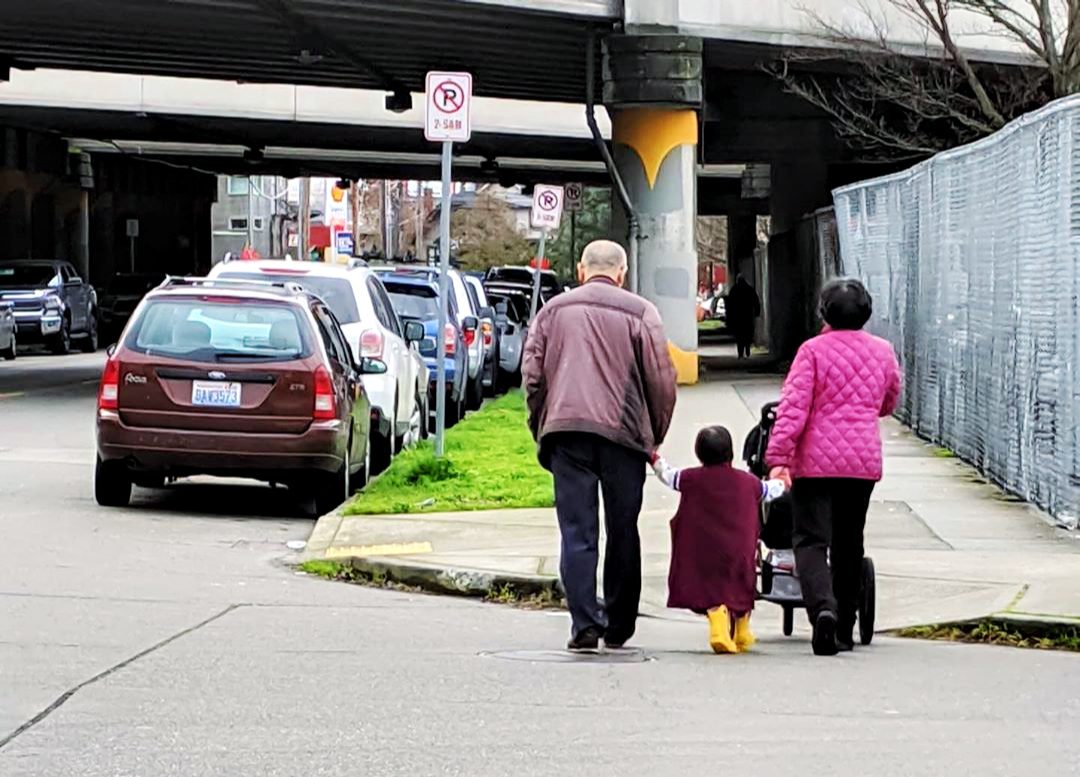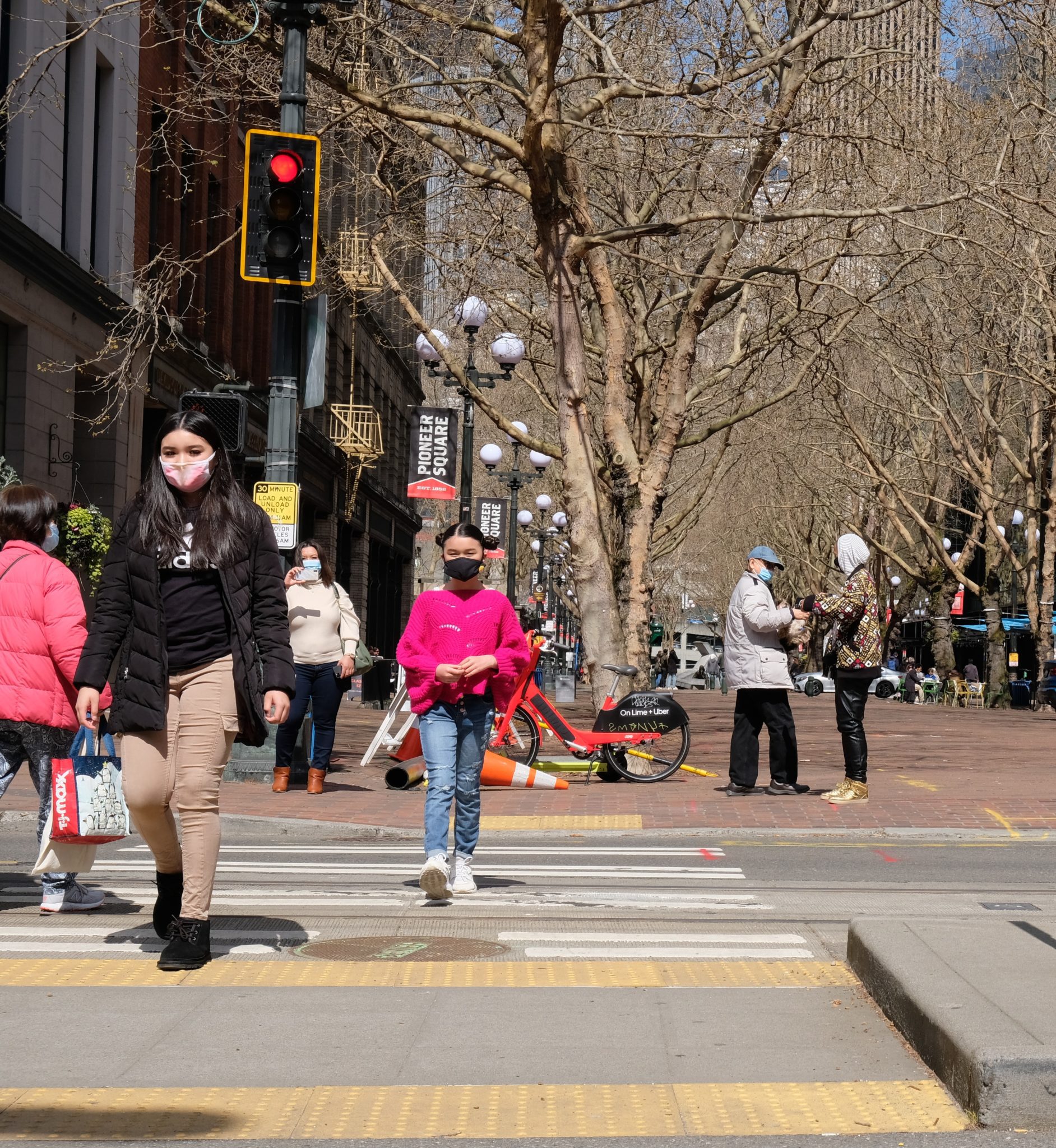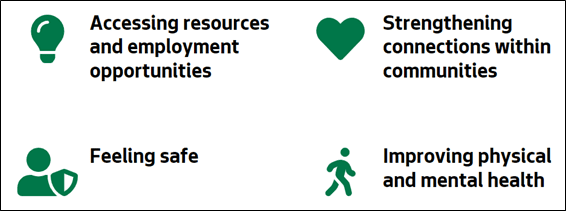 Three people walk across the street and up a curb ramp while pushing a stroller in Seattle. Photo: SDOT.
Three people walk across the street and up a curb ramp while pushing a stroller in Seattle. Photo: SDOT. Walking or rolling with a mobility-assisting device (such as a power wheelchair) are some of the most core and essential forms of affordable, everyday travel. Everyone should be able to navigate the city safely, as part of a wide range of travel and mobility options, from walking, rolling, and biking, to riding transit, to driving if and when needed.
In order to ensure that we are elevating equity and effectively prioritizing safe and comfortable travel for all Seattle community members – especially people who have been historically underserved by public transportation, or may need additional support to get around, our team is conducting a Pedestrian Program Racial Equity Analysis.
This evaluation will help us to better understand current conditions and potential barriers to mobility for all people, and ultimately improve our Pedestrian Program to meet the needs of everyone walking and rolling in Seattle.

In 2017, we developed the Seattle Pedestrian Master Plan with everyone in mind. The plan provides a 20-year blueprint to achieve our vision of Seattle as the most walkable and accessible city in the nation.
To help achieve the vision, our Pedestrian Master Plan established 4 goals:
- Safety: Reduce the number and severity of crashes involving pedestrians
- Vibrancy: Develop a connected pedestrian environment that sustains healthy communities and supports a vibrant economy
- Equity: Make Seattle a more walkable and accessible city for all through equity in public engagement, service delivery, accessibility, and capital investments
- Health: Get more people moving to improve health and increase mobility
The plan also includes a number of more detailed objectives and specific performance measures to help us track progress in achieving these goals and objectives. This overarching vision, alongside the objectives and performance metrics help us to:
- Prioritize where we’ll build new sidewalks, pathways, and other pedestrian safety and mobility infrastructure
- Identify intersections for street crossing improvements
- Outline the toolbox of options we’ll use to improve walkability and accessibility
How do Seattle community members benefit from this plan?
The Pedestrian Master Plan guides our work to create more thoughtful, safe, and accessible spaces for people walking or rolling using mobility-assisting devices, especially for the community members and neighborhoods where the need is greatest.
The City of Seattle has a Race and Social Justice Initiative (RSJI), which was established in order to end institutionalized racism and race-based disparities in City government. To help advance this vision, the Seattle Office for Civil Rights developed a standard citywide Racial Equity Toolkit to be applied to help guide the development, implementation, and evaluation of policies, initiatives, programs, and budget issues to address the impacts on racial equity.
Subsequently, our team at SDOT has completed a Racial Equity Toolkit process for our Pedestrian Program to help ensure our program aligns with these overall citywide principles regarding equity and social justice, as outlined in the Citywide Initiative. This work also supports our commitment to close partnerships and coordination between City of Seattle departments, teams, and staff members, in order to better serve the public, an effort we call our One Seattle approach.
Our vision through the Pedestrian Program is that all people in Seattle have access to safely walk or roll to their destinations, which provides numerous of benefits, including:

Check out this 2-minute video to hear an overview of some of the safety infrastructure elements we’ve been installing throughout Seattle to make it safer for people to walk and roll through the city:
Our Pedestrian Program Racial Equity Analysis will help us to better understand current barriers that can sometimes make it challenging for people walking or rolling with a mobility device to travel safely and comfortably in the city – particularly for individuals living in underserved neighborhoods, due in large part to a lack of investment in public transportation infrastructure over many decades.
The analysis, which is being completed in collaboration with community members, will evaluate racial, cultural, ethnic, and language differences, and help determine how they may affect people’s ability to navigate their neighborhoods while walking or rolling. This analysis will help us to identify ways to help these community members better meet their daily mobility needs and complete trips more safely and with more comfort in the future.
We believe this analysis will also allow us to build deeper relationships with community members and neighbors. We expect it will also help improve our understanding of walking and accessibility challenges that exist today, so we can make the best and most appropriate changes where needed. Lastly, we anticipate the analysis will help us improve outcomes and better explain why investing these safety resources is important.
We’ll also apply what we learn from the analysis to adjust our work moving forward to make meaningful pedestrian safety and mobility improvements – especially for individuals in neighborhoods who need it the most to be able to safely travel by foot or while rolling.
Another goal of this blog post, the video included, and our future outreach, is to help familiarize everyone in Seattle with what pedestrian safety infrastructure and resources may be available, and build greater understanding of what elements could potentially make their neighborhood safer, more comfortable, and more vibrant in the future.
You can visit our Pedestrian Program Racial Equity Analysis web page for more information about this work.
Next steps
We’ll continue to share additional updates over time via the SDOT Blog, as well as our Pedestrian Program Racial Equity Analysis web page, where we’ll post more information about our analysis and informational resources for the public, as updates are available.
You can also follow us on Twitter at @seattledot for our latest news and information, including pedestrian safety and equity-related updates moving forward!

